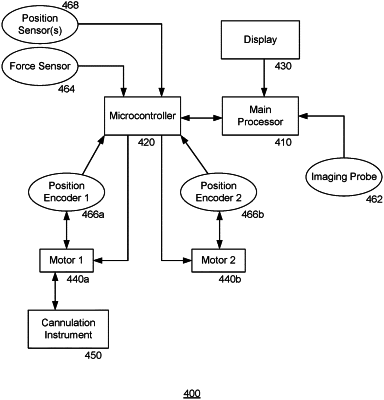| CPC A61B 8/0841 (2013.01) [A61B 8/06 (2013.01); A61B 8/12 (2013.01); A61B 8/4218 (2013.01); A61B 8/466 (2013.01); A61B 2034/2065 (2016.02); A61B 2562/0219 (2013.01)] | 19 Claims |

|
1. A device comprising:
an imaging probe for continuously generating imaging data of a target location under a patient's skin, wherein the target location is a center of a target vessel;
a positioning unit including:
a plurality of motors configured to manipulate a cannula attached to the positioning unit toward the target location,
at least one cannula position sensor configured to generate cannula pose data indicating a position and orientation of the cannula based on movement of the corresponding motors; and
at least one device position sensor configured to generate device pose data indicating an orientation and position of the device; and
a processor configured to:
receive imaging data from the imaging probe;
receive cannula pose data from the at least one cannula position sensor;
receive device pose data from the at least one device position sensor;
identify the target location from the imaging data;
determine a trajectory for manipulating the cannula towards the target location based on the imaging data, the cannula pose data, and the device pose data;
instruct the positioning unit to manipulate the cannula according to the determined trajectory;
identify the determined trajectory becoming misaligned with the target location based on a detected motion of the target location;
update the determined trajectory to a corrected trajectory based on the imaging data, the cannula pose data, and the device pose data; and
instruct the positioning unit to manipulate the cannula according to the corrected trajectory.
|